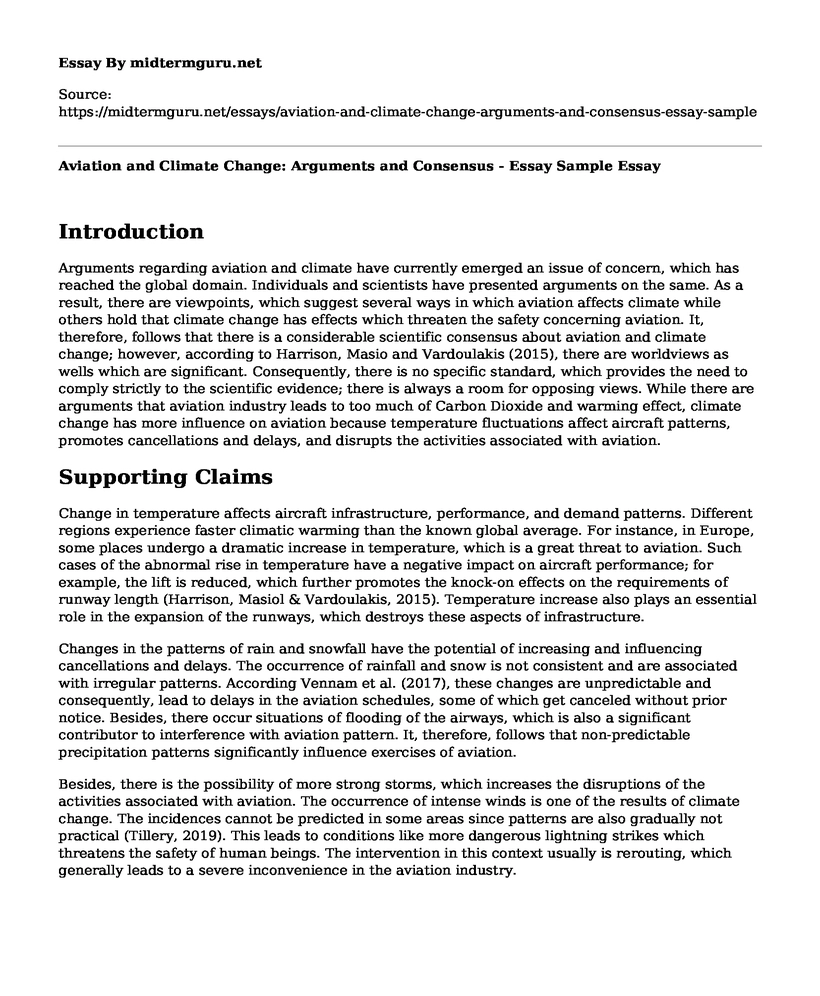Introduction
Arguments regarding aviation and climate have currently emerged an issue of concern, which has reached the global domain. Individuals and scientists have presented arguments on the same. As a result, there are viewpoints, which suggest several ways in which aviation affects climate while others hold that climate change has effects which threaten the safety concerning aviation. It, therefore, follows that there is a considerable scientific consensus about aviation and climate change; however, according to Harrison, Masio and Vardoulakis (2015), there are worldviews as wells which are significant. Consequently, there is no specific standard, which provides the need to comply strictly to the scientific evidence; there is always a room for opposing views. While there are arguments that aviation industry leads to too much of Carbon Dioxide and warming effect, climate change has more influence on aviation because temperature fluctuations affect aircraft patterns, promotes cancellations and delays, and disrupts the activities associated with aviation.
Supporting Claims
Change in temperature affects aircraft infrastructure, performance, and demand patterns. Different regions experience faster climatic warming than the known global average. For instance, in Europe, some places undergo a dramatic increase in temperature, which is a great threat to aviation. Such cases of the abnormal rise in temperature have a negative impact on aircraft performance; for example, the lift is reduced, which further promotes the knock-on effects on the requirements of runway length (Harrison, Masiol & Vardoulakis, 2015). Temperature increase also plays an essential role in the expansion of the runways, which destroys these aspects of infrastructure.
Changes in the patterns of rain and snowfall have the potential of increasing and influencing cancellations and delays. The occurrence of rainfall and snow is not consistent and are associated with irregular patterns. According Vennam et al. (2017), these changes are unpredictable and consequently, lead to delays in the aviation schedules, some of which get canceled without prior notice. Besides, there occur situations of flooding of the airways, which is also a significant contributor to interference with aviation pattern. It, therefore, follows that non-predictable precipitation patterns significantly influence exercises of aviation.
Besides, there is the possibility of more strong storms, which increases the disruptions of the activities associated with aviation. The occurrence of intense winds is one of the results of climate change. The incidences cannot be predicted in some areas since patterns are also gradually not practical (Tillery, 2019). This leads to conditions like more dangerous lightning strikes which threatens the safety of human beings. The intervention in this context usually is rerouting, which generally leads to a severe inconvenience in the aviation industry.
Opposing Views
The opposing side in this context has arguments, which are based on the potential of aviation to trigger climate change. One of such claims provides that aviation has emerged one of the top human-related causes of emission of carbon dioxide into the environment, which further leads to global warming. Besides, there is a view that aviation is responsible for the occurrences of contrails, which increase the warming effect (Vennam et al., 2017). Contrails form from the ice and water droplets that the jet fuels release at high altitudes. These restrict the heat from the earth from escaping, which further concentrates in the environment. This is believed to be a significant contributor to climate change.
Claim
Even though others claim that the industry of global aviation facilitates climate change, the latter has a considerable influence on the former. This is because temperature affects aircraft infrastructure, performance, and demand patterns. Besides, the changes in the patterns of rain and snowfall have the potential of increasing and influencing cancellations and delays. Finally, there is the possibility of more strong storms, which increases the disruptions of the activities associated with aviation.
References
Harrison, R., Masiol, M., & Vardoulakis, S. (2015). Civil aviation, air pollution and human health. Environmental Research Letters, 10(4), 041001. Doi: 10.1088/1748-9326/10/4/041001
Tillery, B. (2019). Integrated science (7th ed.). Mcgraw-Hill Rental.
Vennam, L., Vizuete, W., Talgo, K., Omary, M., Binkowski, F., & Xing, J. et al. (2017). Modeled Full-Flight Aircraft Emissions Impacts on Air Quality and Their Sensitivity to Grid Resolution. Journal Of Geophysical Research: Atmospheres, 122(24), 13,472-13,494. Doi: 10.1002/2017jd026598
Cite this page
Aviation and Climate Change: Arguments and Consensus - Essay Sample. (2023, Jan 12). Retrieved from https://midtermguru.com/essays/aviation-and-climate-change-arguments-and-consensus-essay-sample
If you are the original author of this essay and no longer wish to have it published on the midtermguru.com website, please click below to request its removal:
- Essay on the Future of Renewable Energy in Turkey
- African Animals on Endangered Species List - Paper Example
- Debunking Media Matters: Is It Media the Major Cause of Terrorism - Paper Example
- Article Analysis Essay on Shooting in The Dark
- Research Paper on Fighting Racism in America
- GMOs Impact Global Food Production: Benefits of Genetically Modified Crops - Essay Sample
- Managing Cancer Risk: Smoking and Avoids Relapse - Essay Sample







